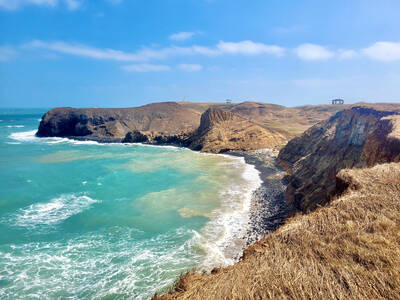We’ve already seen one of the unforeseen effects of global warming. The eco-documentary has become as much of a staple of the cinema schedules as the duff geezer flick or the drippy indie romcom. Round they come, the green screen hopefuls, month in, month out, as sure as rising sea levels and — sometimes, at least — almost as wet.
There are the ones about the end of the world. There are single-issue ones, about soil or oil or fish. There are gimmicky ones, in which a man spends a month scoffing Big Macs, or a year living carbon-neutral, or goes for swims in polluted rivers, or faces up to the fact that he’s not going to be president. There are ones that make you swap lightbulbs, the ones that suggest you adopt a goat. There are ones in glossy 3D, featuring an A-list actor doing the voiceover and endangered beasties scuttling about under an ominous sky.
Next week, there’s another one. But The Cove is different. This is an eco-documentary that doesn’t assume being right is enough to put bums on seats. It doesn’t make the mistake of thinking that a gap in education is the problem that most pressingly needs addressing; its producers know that if you’re forking out to see it, chances are you’re already well informed. The Cove has no room for the dimwit voiceover (by contrast, The Vanishing of the Bees, out last week, addresses its audience as if they were at the movies to fill the gap between literacy hour and playtime). It has no room, either, for any disappointed tutting, as perfected by The Age of Stupid’s Pete Postlethwaite, last man standing in a climate-fried 2055, shaking his head over film of people squandering the Earth’s resources in 2009. Nor does it bombard the viewer with diagrams, statistics or action checklists.
In fact, it’s slick, zippy entertainment. Pierce Brosnan told The Cove’s director, Louie Psihoyos, it was the best heist movie he’d ever seen. The New York Times called it a “Trojan horse ... an exceptionally well-made documentary that unfolds like a spy thriller, complete with bugged hotel rooms, clandestine derring-do and mysterious men in gray flannel suits.”
The Cove’s subject is the slaughter of wild dolphins in one small cove in Japan — some 23,000 of them each year. This was brought to the attention of Louie Psihoyos, previously a photographer for National Geographic, by Ric O’Barry, a former trainer of Flipper who is now an animal activist. Many knew about the killing, but no one had ever witnessed it — apart from the hired harpooners who would trap the dolphins in the heavily guarded cove, then kill them. So Psihoyos assembled a crack team to help him get the footage, including Olympic divers, an air force engineer, a stuntman and a team of designers from Industrial Light & Magic, who hid cameras in fake rocks to be planted around the cove.
The Cove is thrilling: exuberant, amusing, theatrical. Until, that is, it gets to the footage of the slaughter. Then it’s horrific. Cinematical’s reviewer wrote that, in a career watching horror films, “I’ve never seen anything quite as disturbing as the final sequences of The Cove.”
Leaving aside the fact that the most impressive footage in the film was, in fact, shot by a rock, it’s a virtuoso piece of movie-making. To secure young audiences, despite the horrors, Psihoyos aped Hitchcock’s Psycho shower scene, never actually showing a harpoon piercing flesh (there’s always a layer of water between them). The whole film, it turns out, was meticulously pieced together in post-production — its plot born of the cutting room, not the storyboard. “It happened organically,” says Psihoyos. “We let it tell it itself.”
That is why The Cove succeeds. It doesn’t nag or holler; it lets its audience join the dots. It’s made by people with enough detachment to be sly, satiric, even aesthetic. It is the closest thing green cinema has got to its own Dr Strangelove.
Most eco-docs, on the other hand, are labors of love, and proud of it; made not to tell a story but to save the world. “It’s everything I ever wanted to say in my whole life,” explained one director I spoke to. But such drive, through admirable, cripples any lightness of touch and ensures the audience will exit the cinema with a one-note reaction — be it rage, despair or boredom. Says Psihoyos: “I love documentaries, but I always start looking at my watch. It’s like taking medicine or eating your vegetables — you’d always rather eat your sweets first.”
The Cove dishes out a lot of sweets, and has been appreciated accordingly. At some point over next 10 days or so it’s likely to enter the 100 top-grossing documentaries ever. Impressive, eh? Very, compared to the competition. Last weekend, The Vanishing of the Bees opened across 24 British cinemas to take a total of US$3,513 — that’s an average of US$146 per screen. The Cove has so far taken about US$810,000 in the US.
But to enter the overall 100 top-grossing films, it would need to take some 419,753 times more than it has so far managed (Shrek is currently at 100, with an inflation-adjusted US$340 million box-office total). That gives an idea of the small reach of even the most successful eco-doc.
The lesson seems clear: eco-documentaries can’t compete at the multiplex. So why don’t they just ditch the doc bit altogether? Why not bite the bullet and spread the message via the medium of the blockbuster, as in Roland Emmerich’s eco-disaster film The Day After Tomorrow?
The main stumbling block seems to be Hollywood. In mainstream cinema, big bangs rule. Road movies rock. Nature is, by and large, an unpredictable enemy, to be tamed, not saved. Fireballs are awesome — when they’re caused by an exploding helicopter. Rock crevices are dramatic — when you nip across them on a rope bridge. The most chilled-out surfing flick only climaxes once that wave has been mastered.
Even films with such apparently impeccable eco-credentials as, say, Wall-E, Pixar’s comedy about a world desiccated by overconsumption, look, on closer inspection, like red herrings of a new green wave. Filmmakers can’t really get away with films that don’t chime with what children are taught in school. And it’s worth remembering that the film Pixar made before Wall-E was Cars, a hymn to all things auto, whose climatic act of redemption involves road resurfacing.
It’s peculiar, says film theorist Christopher Frayling. “One of the staples of cinema is fear. You would have thought you could prey on that,” he says. “In the 1930s people were worried about maverick scientists cooking up something nasty in their garrets. In the 1950s it was a nuclear worry, in the 1970s it was volcanoes and earthquakes, and recently we’ve had films like The Matrix about a parallel digital universe. Yet no one has yet found a successful idiom for making us feel anxious about the environment.”
Previous attempts act as a heavy disincentive: they’re either embarrassing, like last year’s remake of The Day the Earth Stood Still, which turned the nuclear threat of the 1951 original into an ecological one, or catastrophic, like Kevin Costner’s Waterworld. And when filmmakers have tried, they’ve bottled it. Danny Boyle’s provocative Sunshine morphed into a standard maniac-in-space horror two-thirds of the way through. The Day After Tomorrow and I Am Legend showed us that however close the human race comes to extinction, we will pull through in the end. It’s dangerous — by indulging our hopes, cinema may well be adding to our difficulties, helping us kid ourselves.
This brings us to The Road, John Hillcoat’s forthcoming adaptation of Cormac McCarthy’s bleak, post-apocalyptic horror novel. After a troubled production, it finally arrives in the UK in January, complete with moderately hopeful conclusion, including a final image one colleague described as a “cheesy freeze-frame.” Quite different, then, from the end of the book — perhaps the most nihilistic, and most important, literary exploration of a post-climate change world.
So, does one throw up one’s hands and curse those damned studios for their avarice, their cowardice? No. Films function in a different way to books. You don’t read a book on a date. You might go and see The Road, however — and so an ending that doesn’t leave you wanting to jump off a cliff is part of the deal when you buy your ticket.
And that’s where Louie Psihoyos thinks he’s cracked it. “The Cove is the ultimate date movie,” he says. “I think that at the movies, women like to feel, and guys to be excited. Just about everyone likes this movie, and it’s one you won’t struggle to talk about over supper.” And, praise be, he’s right. Unless you’ve ordered sushi.

Following the shock complete failure of all the recall votes against Chinese Nationalist Party (KMT) lawmakers on July 26, pan-blue supporters and the Chinese Communist Party (CCP) were giddy with victory. A notable exception was KMT Chairman Eric Chu (朱立倫), who knew better. At a press conference on July 29, he bowed deeply in gratitude to the voters and said the recalls were “not about which party won or lost, but were a great victory for the Taiwanese voters.” The entire recall process was a disaster for both the KMT and the Democratic Progressive Party (DPP). The only bright spot for

As last month dawned, the Democratic Progressive Party (DPP) was in a good position. The recall campaigns had strong momentum, polling showed many Chinese Nationalist Party (KMT) lawmakers at risk of recall and even the KMT was bracing for losing seats while facing a tsunami of voter fraud investigations. Polling pointed to some of the recalls being a lock for victory. Though in most districts the majority was against recalling their lawmaker, among voters “definitely” planning to vote, there were double-digit margins in favor of recall in at least five districts, with three districts near or above 20 percent in

From Godzilla’s fiery atomic breath to post-apocalyptic anime and harrowing depictions of radiation sickness, the influence of the nuclear bombings of Hiroshima and Nagasaki runs deep in Japanese popular culture. In the 80 years since the World War II attacks, stories of destruction and mutation have been fused with fears around natural disasters and, more recently, the Fukushima crisis. Classic manga and anime series Astro Boy is called “Mighty Atom” in Japanese, while city-leveling explosions loom large in other titles such as Akira, Neon Genesis Evangelion and Attack on Titan. “Living through tremendous pain” and overcoming trauma is a recurrent theme in Japan’s

The great number of islands that make up the Penghu archipelago make it a fascinating place to come back and explore again and again. On your next trip to Penghu, why not get off the beaten path and explore a lesser-traveled outlying island? Jibei Island (吉貝嶼) in Baisha Township (白沙鄉) is a popular destination for its long white sand beach and water activities. However, three other permanently inhabited islands in the township put a unique spin on the traditional Penghu charm, making them great destinations for the curious tourist: Yuanbeiyu (員貝嶼), Niaoyu (鳥嶼) and Dacangyu (大倉嶼). YUANBEIYU Citou Wharf (岐頭碼頭) connects the mainland